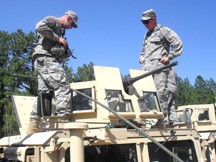FORT POLK, La. -- Every nine weeks, the small group advisors of 4th Battalion, 353rd Infantry Regiment, 162nd Infantry Brigade, take under wing a new class of combat advisors preparing to deploy from Fort Polk as mentors to Afghan and Iraqi military counterparts. With each class comes a new set of challenges.
The advisors often inherit a mixed group of combat advisors from different military branches. Most come from wide-ranging professional backgrounds and installations with ranks ranging from E-1 to O-5. Once their 21-, 45- or 60-day training cycle is complete, most of these newly-trained combat advisors deploy to individual assignments across the globe. Throughout the 162nd's (Tiger Brigade's) specialty training, the small group advisor maintains cohesion for these trainees.
"We are expected to teach, mentor and advise individuals who not only don't know you, but usually don't know each other either when they arrive for training," said Staff Sgt. Alejo Sanchez, a 4th Bn small group advisor. "The only thing they can really hope for when they get here is that they have at least a few more people that will be in the same branch of service as them."
The six-man small group advisor team from 4th Bn is tasked through the unit's Headquarters and Headquarters Company. Combat advisor teams traditionally range in size from nine to 12 personnel, with two to three small group advisors assigned as liaisons for each team.
The company's primary responsibility is to coordinate advisor training, which is spread throughout the Tiger Brigade, and ensure combat advisors attend training prepared and equipped to learn. That training covers a wide spectrum, from cultural understanding and foreign language to combat skills like mounted combat patrol and counter-improvised explosive device battle drills.
Additionally, 4th Bn's small group advisor team provides its own supplemental training to assist combat advisor teams in their day-to-day mission planning and operations. The small group advisor-led training includes troop leading procedures, conducting key leader engagements, recovering a downed vehicle and performing pre-combat checks, inspections and preventive maintenance on vehicles.
"The training program we devised is done in a semi-formal environment and helps the trainee to build confidence in core skills," said Staff Sgt. Peter King, another 4th Bn small group advisor. "Since many trainees are from other branches, like the Air Force and Navy, this additional training serves as a filler to help them understand core competencies, such as map reading."
Besides facilitating training, advisors serve as administrative NCOs on behalf of their trainees, tracking personnel issues such as medical and finance. They also gauge team performance and conduct after-action reviews with the teams to help them to identify strengths and deficiencies.
Since the Tiger Brigade began training combat advisors in August 2009, 4th Battalion has overseen six classes totaling 192 combat advisors. The company's current class, Class 111, includes 37 regular Army Soldiers, Minnesota National Guardsmen and Air Force personnel. The class began training Oct. 25. One of those teams, the Minnesota National Guard, graduated in November under the Tiger Brigade's aggressive, 21-day training model. They have since departed for follow-on training in Germany before eventually deploying to Croatia and then Afghanistan.
The remaining teams -- an Army federal police transition team bound for Iraq and the Air Force team with personnel bound for Afghanistan and Iraq -- continue to train at Fort Polk under the standard 60-day training model and will deploy in the coming months.
"We are the only personnel here at the 162nd that stay with the combat advisors from the beginning to the end of their training," said Staff Sgt. Kevin Wellington, 4th Bn. "As a result, strong and lasting bonds often form between the small group advisors and the combat advisors that extend well beyond their time spent here. We often stay in contact with the combat advisors throughout their deployment and beyond -- on a regular basis, we send additional training material digitally to them in the field as requested."


Social Sharing